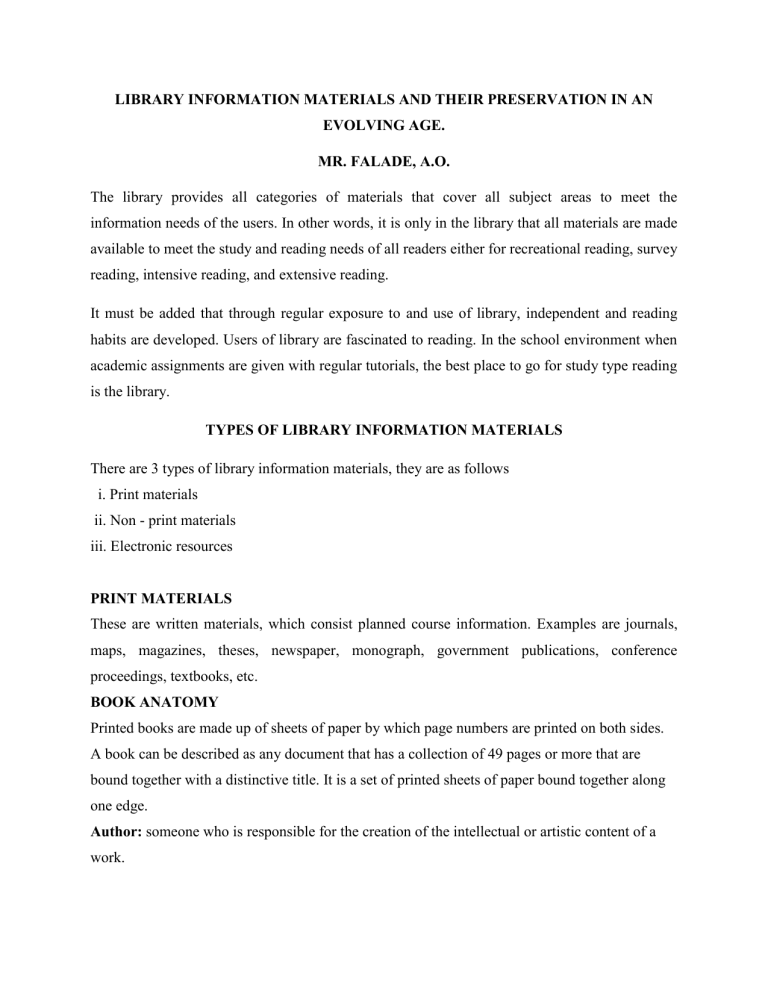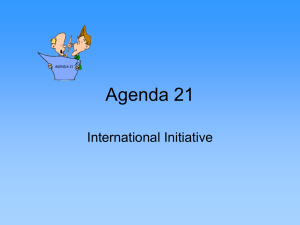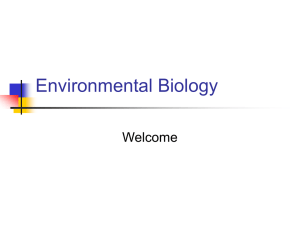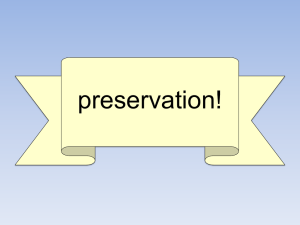
LIBRARY INFORMATION MATERIALS AND THEIR PRESERVATION IN AN EVOLVING AGE. MR. FALADE, A.O. The library provides all categories of materials that cover all subject areas to meet the information needs of the users. In other words, it is only in the library that all materials are made available to meet the study and reading needs of all readers either for recreational reading, survey reading, intensive reading, and extensive reading. It must be added that through regular exposure to and use of library, independent and reading habits are developed. Users of library are fascinated to reading. In the school environment when academic assignments are given with regular tutorials, the best place to go for study type reading is the library. TYPES OF LIBRARY INFORMATION MATERIALS There are 3 types of library information materials, they are as follows i. Print materials ii. Non - print materials iii. Electronic resources PRINT MATERIALS These are written materials, which consist planned course information. Examples are journals, maps, magazines, theses, newspaper, monograph, government publications, conference proceedings, textbooks, etc. BOOK ANATOMY Printed books are made up of sheets of paper by which page numbers are printed on both sides. A book can be described as any document that has a collection of 49 pages or more that are bound together with a distinctive title. It is a set of printed sheets of paper bound together along one edge. Author: someone who is responsible for the creation of the intellectual or artistic content of a work. Compiler: someone who produces a work by collecting and putting together written or printed works of various authors. Physically a printed book can be divided as follows: a. The Binding b. The Preliminary Pages c. The text d. The Ancillary Binding This is the part of the book that holds the leaves of the book together. It also protects the leaves and makes them easy to handle. Occasionally, the author’s name and the title of the book appear on the binding. The part of the binding which conceals the individual printed paper which has been folded and sewn is called the spine. Preliminary Pages Fly leaves: these are blank pages next to the end of papers, i.e. they are the first and last leaves in the book unlike the end papers and they are not stuck down to the book. Half-Title Page: It precedes the title page. It serves to protect the title page. The wording of the long title is often abbreviated, thus it gives a brief title of the book and the series title, if the book belongs to a series. It is sometimes called a bastard title. Title Page: this page gives the full title and also author’s name in full together with particulars of qualification, degree, edition, publisher’s name and address. Copyright Page or Verso Page: the verso page of the title page (i.e. the reverse side of the title page) gives the date of copyright i.e. the date of publication, the ISBN (International Standard Book Number) and occasionally the Library of Congress Classification, Dewey Decimal Classification Numbers/Catalogue in Print (CIP) ISBN International Standard Book Number This is the number allocated to each book which is unique to the book. It usually contains then digits. The ISBN number is used to identify which books are published in a country and even by a reputable publisher. Codes have been allocated by continent followed by countries/publishers. Dedication Page This page follows the title page. It bears the name(s) of person(s) to whom the author dedicates the book. Occasionally, it may be dedicated to a group of people. Table of Contents Page This page gives a list of preliminaries; it may be chapter headings of the book with the relevant page numbers. List of Illustrative Materials Where available, these are generally photographs, drawings, portraits, maps, plates, tables, diagrams, etc. placed in the text. It gives the relevant pages of the illustrations. Preface The author gives reasons for writing the book and his after thoughts. It indicates those for whom the book is intended and acknowledges those who have contributed in one way or the other in the course of writing the book. The author generally explains the arrangements, symbols and abbreviations used. Introduction The author gives a general survey of the subject matter. Text After the preliminary pages is the text of the book which is the most important part of the book and most bulky. Ancillary This is the last part of the book. Generally, it may include the following: i. i. Appendix ii. Glossary iii. Bibliography iv. Index Appendix: the appendix comes at the end of the text of a book and contains notes which are too long for footnotes, tables, statistics or other items of which there is no room in the body of the book. These are generally referred to in the text but not explained. ii. Glossary: it is the section that explains difficult or technical words used in the text. iii. Bibliography: it gives a list of books, articles and other materials which the author has used in writing the book. It may also be a list of books for further reading and to widen the borazon knowledge and understanding of the users in that specific area of study. Bibliographies are arranged in alphabetical order. iv. Index: an index is a list; systematically arranged, giving enough information for each item to be traced in the text by means of a page number or other symbols indicating its position in a sequence. It may be author index or place index. NON-PRINT MATERIALS These can be defined as any materials available in form other than printed materials. Examples are discs, cassettes, slides, projectors, films, microfiche, ultra-fiche, video tapes, computers, floppy disk, and flash disk. ELECTRONIC RESOURCES These are resources in electronic forms. An electronic resource is defined as a resource which requires computer access or any electronic product that provides a collection of data. Examples are electronic books (e-books), electronic journals (e-journals), online databases, websites, CD ROM, diskettes, etc. CONSERVATION AND PRESERVATION OF LIBRARY MATERIALS Library users must be instructed in the proper use and handling of books and other library information materials. Exposure to water, excessive heat, tearing of pages, breaking of covers, marking of pages with pencils or biro, allowing grease to get on to the pages and turning down the cover pages, all tends to man and damage the book and it will quickly send the book or materials out of circulation, and thereby. This demands for the proper preservation and conservation of the library materials. Any librarian responsible for the preservation of these documentary heritages should know the various causes of deterioration of the library materials and the possible methods for their preservation. DEFINITION OF TERMS CONSERVATION: is concerned with reducing or preventing damage in order to extend the life expectancy of collections. Conservation can be defined as the maintenance of documents in a usable condition through treatment and repairs of individual items to slow the process of decay or to restore them to a usable state.It is the maintenance of each item in the collection in a usable condition. Conservation includes study, diagnosis, preventive care, examination, treatment, documentation using any methods that may prove effective in keeping that property in as close to its original condition as possible and for as long as possible. The conservation actions are carried out for a variety of reasons including aesthetic choices, stabilization, needs for structural integrity or for cultural requirements for intangible continuity PRESERVATION: refers to the physical treatment of individual items especially after some damage has occurred. “Preservation is an action taken to anticipate, prevent, stop or delay deterioration.” Preservation is the task of minimizing or reducing the physical and chemical deterioration of documents.The library keeps the document by considering the long-term preservation of the items while still allowing the end user to access the material easily. The purpose of preservation is to make sure that library materials do not get damaged quickly. Preservation can also prolong the life of a library material. TYPES OF PRESERVATION AND CONSERVATION TECHNIQUES: (i) Preventive Conservation: Many cultural works are sensitive to environmental conditions such as temperature, humidity and exposure to light and ultraviolet light. Taking sufficient measures protect materials in a controlled environment where such variables are maintained within a range of damage-limiting levels called preventive conservation. (ii) Interventive Conservation: Interventive conservation refers to any act by a conservator that involves a direct interaction between the conservator and the cultural material. These interventive treatments could involve cleaning, stabilizing, repair, or even replacement of parts of the original object or consolidation such as securing flaking paint. FACTORS OF DETERIORATION Deterioration is a change of original state of any materials by interaction between the object and the factor of destruction. The different types of deterioration of the paper based material are reflected in wear and tear, shrinkage, acidic, cracks and brittleness. Also, acidic and other gases present in the atmosphere and harmful chemicals added during production affect the longevity of materials especially books. The preservation and conservation of information materials is an essential preliminary to the effective exploitation of library materials. As the quality of knowledge expands the need to preserve it becomes more pressing. A vast number of different means of preserving and conserving information materials have been devised and exploited since the earliest of times. With the vast output of new information and ever increasing degrees of specialization in all areas of human knowledge, heavy demands are being made on library information storage and retrieval system which can scarcely be met by the traditional methods. Generally, library materials are susceptible to deterioration by the following factors: Chemical factor: These are caused majorly by airborne contaminants in the form of gases and particulates can jeopardize the preservation of library materials. Acid and gaseous are the arch enemy of Librarians because it is a direct cause for hydrolysis. Hydrolysis is a chemical product. As time goes by, acid contaminated paper loses its strength and becomes increasingly brown stained and is eventually brittle to the extent that it cannot be handled without crumbling. Gaseous pollutants can originate indoors from photocopiers, painting, untreated wood and certain kinds of adhesives and plastics. The pH value is a very reliable measure of acid content. pH is the measure of the hydrogen ion concentration of a substance. pH establishes a direct correlation between paper acidity and longevity. The more acidic the paper, the short lived it is. Biological factors Biological agents that destroy library materials include mold, mildew, fungi, bacteria, insects, rodents and man. The most common species affecting library and archives materials are silver, fish, bookworms, booklice and cockroaches. Most insects are not attracted to the paper but rather to sizing, adhesives and starches that are dark, wet, dirty, clustered and undisturbed. The nature and extent of the damage depends not on the insect and material but also on how promptly the infestation is discovered and controlled. They are especially attracted by the starch in the book bindings and glues. The climatic conditions in Africa favour the insects to thrive in the library, hence they easily destroy books. A clean and well ventilated and climate controlled environment goes a long way towards preventing infestation to any of these pests. Environmental factors Researches indicate that cooler temperature is preferred to library materials. The materials should not be exposed to too much light, there are two types of light both artificial (controllable) and natural light (less controllable) both types of light contribute in a way to cellulose degradation and fading of pigments and dyes. It speeds up the oxidation of paper and thus its chemical breakdown. It causes paper to be yellow or brown. The higher the intensity, the greater the damage. These dimensional changes weaken physical bonds and set up stresses that can shorten the life of most materials. If atmospheric conditions are too dry, materials will become brittle and more susceptible to cracking particularly during handling. Light is very vital in the provision of library services since materials have to be identified and read. Mechanical Factors Mechanical damages to collections can be caused by a range of events, including vandalism, earthquakes, fire and water damage, careless handling, improper support during storage, and inadequate packaging for transport. These direct physical forces are extremely likely to result on damage, so every effort must be made to protect collections from physical harm. METHODS OF PRESERVING PRINT AND NON PRINT MATERIALS 1. Storage: Store books away from sources of heat and moisture. Position bookcases so that sunlight does not fall on books you want to preserve. 2. Shelving: Shelve books of approximately the same size together so they will support one another; otherwise, they will become distorted and lose their shape. 3. Handling: Handle books gently to avoid separating covers and spine pieces from the binding. 4. Fumigation:this method is carried out by smoking smoke or spraying the libraryto prevent the growth of fungi,kill animals and destroyers of library materials. 5. De-acidification: this is the preservation of library materials by stopping the acidity process contained in the paper. 6. Lamination: this is coating the library material with special paper, so that the library material becomes durable. 7. Encapsulation:this is the method to protect paper from physical damage, for example brittle due to age, exposure to acid, insects’ consumption, improper storage, etc. 8. Binding:this is the method of combining separate sheets into one, which is protected by a protective cover. 9. Photocopying: Do not place books face down on a photocopier or scanner. Book cradles can support books at a safe angle to protect the bindings. PRESERVATION OF ELECTRONIC RESOURCES 1. Refreshing: It can be done by transferring data from the same old to new storage media. 2. Migration: This is transferring data from old system environment to new one. 3. Replication: Thisis creating duplicate copy of data on more than one system that are situated in different locations. 4. Emulation: creation of new software that can copy the operations of older software and hardware to ensure itsoriginality in terms of physical presence, content and functionality. 5. Encapsulation: This is the inclusion of one thing within another thing so that the included thing is not apparent. 6. Technology Preservation: This involves preserving digital objectsincluding hardware andsoftware required to maintain access to an object.This includes operating systems, originalapplication software and media drives.



